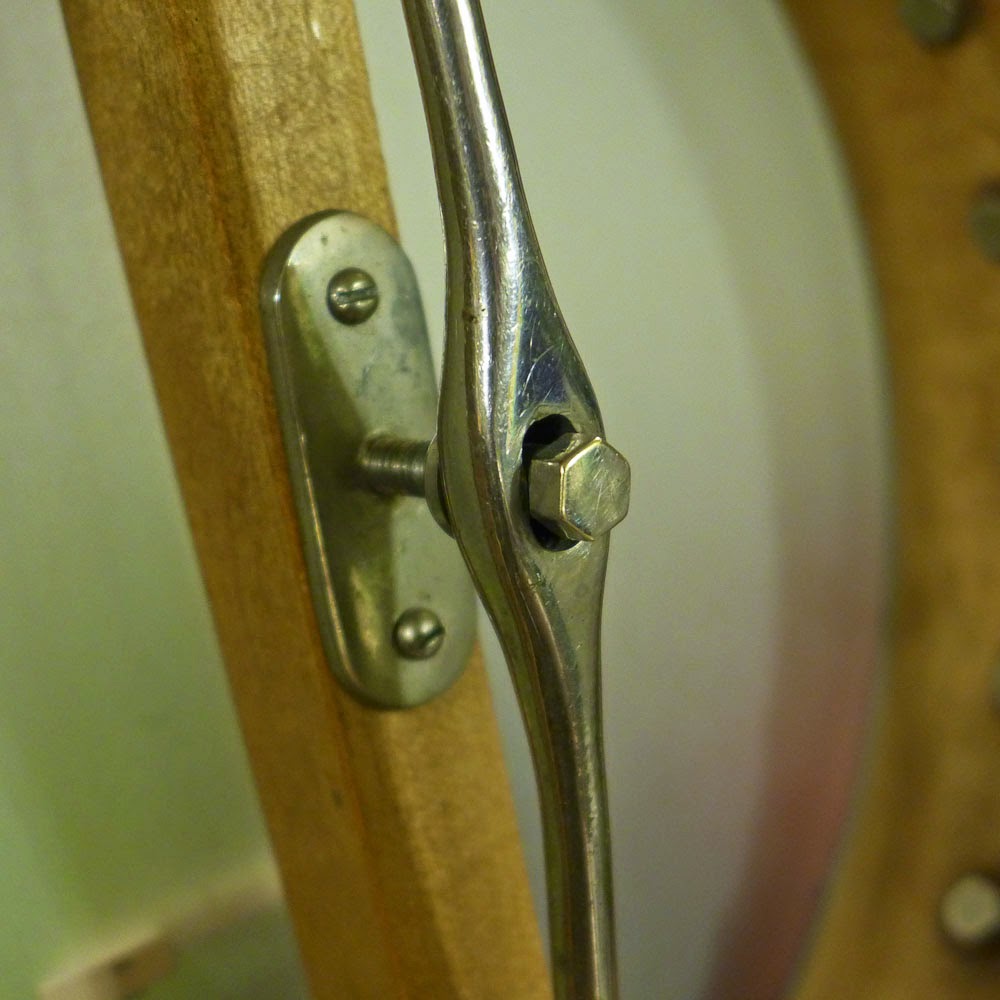c.1923 Weymann Style #140 Openback Tenor Banjo
Weymanns are always a favorite of mine when passing through the shop! Big, robust builds with plenty of structural reinforcement are their hallmark and they sound tops, too. This one is essentially built like a Vega "Little Wonder" with a hoop-in-sleeve tonering though the heavier hardware and bigger rim give it a distinctly warmer sound. It's got plenty of volume but the 10 1/2" head and short 21" scale length mean that while the fingering should be ideal for Celtic (low GDAE-tuned) banjo the tone is much more suited to "Chicago" DGBE tuning (which it's in) or standard CGDA tuning.
Update 12/12/14: I've been playing this one for a while and there have been several alterations. I've added side dots and moved the 10th fret marker to the 9th marker for ease of a guitarist's (or baritone uke-ist's) eyes. In addition a local fellow was interested in this and bludgeoned me into adding guitar-style tuners (hey, they're easier) on it but disappeared off the radar. Since then I've been recording with it but now it's #2 tenor in my stable so it's time for it to find a new home. It's a great little thing and comes with a Taylor gigbag that fits it nicely. I've taken some new photos and they're directly below:
Update 12/12/14: I've been playing this one for a while and there have been several alterations. I've added side dots and moved the 10th fret marker to the 9th marker for ease of a guitarist's (or baritone uke-ist's) eyes. In addition a local fellow was interested in this and bludgeoned me into adding guitar-style tuners (hey, they're easier) on it but disappeared off the radar. Since then I've been recording with it but now it's #2 tenor in my stable so it's time for it to find a new home. It's a great little thing and comes with a Taylor gigbag that fits it nicely. I've taken some new photos and they're directly below:
Now back to the original post and extra information...
And... a brown clip-on luggage strap comes with it as well. I love these for banjos for use as straps as they're easy to get on and off the hooks one normally attaches these too. No tying necessary. Now back to the original post...
Work included the new Renaissance head, a fret level/dress, one replacement hook/nut (vintage parts), new (compensated) bridge, much cleaning, and a setup. She plays beautifully with 1/16" action at the 12th fret and a good clean sound.
I'm actually taking this banjo out tonight for a gig because I know it'll punch right through the other fellas, hah hah.
Stained-maple headstock veneer... original Champion friction pegs... and original bone nut. Note that these are now replaced with guitar-style tuners.
This one has an actual ebony board rather than dyed maple. One of the MOP dots is a replacement but you wouldn't be able to tell. These are also the original frets and they're those very narrow old tiny frets similar to vintage Gibson mandolins.
A compensated bridge makes all the difference. On short scales tuned to DGBE I like to go heavier with the B&E strings. These are gauged 32w D, 22w G, 17 B, 12 E.
Oops... forgot to note that I added new rosewood neck brace shims, too.
The back of the flamed-maple neck (it's a fairly thin profile for the time, by the way) has all these marks. I'm guessing someone was using a cruddy capo without the rubberized backing on it... or else they just kept banging it into something! Who knows?
I lightly sanded and then buffed up the finish around the dinging to make it feel more natural under the hand (ie, smoother).
Here's the inside of that hoop-in-sleeve Little Wonder-style tonering.
Here you can see that neck reinforcement bar in action! The way these work is that as you turn the bolt in the center counter-clockwise you push the bar away from the dowel stick and this pull the heel more tightly to the pot. You still need the standard neck brace (friction-set) installed correctly for proper fit but this stiffening brace means that Weymanns endure seasonal shifts and gigging far better than makes that just use a wooden dowel. They're almost as rugged as solidbody electric guitars...
One bit denoting an earlier Weymann is the non-adjustable, mandolin-style tailpiece. I like them because they hide my afterlength string-muting foam a little better!




































Comments